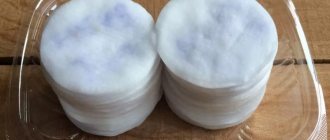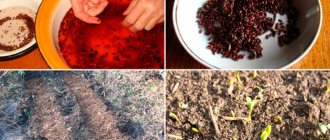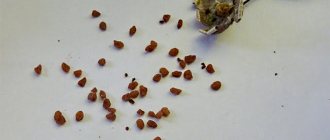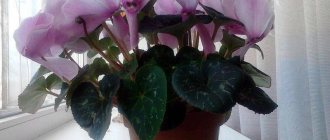Cyclamen is a herbaceous perennial from the Mirsinov family. The plant comes from warm regions: East Africa, Turkey, Iran, the Mediterranean. There it can be found in natural conditions; in temperate latitudes the flower has become a decorative indoor plant. Among the many varieties bred by breeders, Persian and European cyclamen are the most widespread. The tuber gives vitality to the flower. The perennial leaves are dark green with a white or silver pattern. Their lower parts are red-violet. The main decoration of the plant is the magnificent buds on long peduncles.
The shape of the flowers resembles exotic butterflies; their colors can be white, pink, purple and many other shades. The perennial blooms in autumn and blooms all winter, creating a special mood in the apartment. The flower is unpretentious in care, loves coolness and diffused light. Even a novice gardener can grow cyclamen from seeds at home. The seed material has good germination, and professional advice on planting and care will add confidence in your abilities.
How to grow cyclamen: features of growing cyclamen
Keep it cool
Cyclamen does not like heat, the ideal temperature for it is only 16 degrees Celsius, it is in such conditions that this flower will bloom. In summer, the permissible “living” temperature for cyclamen is about 20 degrees.
If the temperature is high, the flowering plant purchased will fade very quickly without releasing new buds.
It is advisable to place the flower on an eastern or western windowsill.
Provide light and air
Cyclamen loves fresh air (but does not tolerate drafts) and good lighting (but not the scorching rays of the sun).
Proper watering
Cyclamen is moisture-loving, and at the same time does not tolerate watering on the leaves or on the tuber. And the ingress of water onto the growth point of the cyclamen tuber is especially critical. So the ideal option would be bottom watering into a tray. After filling the tray with water, you need to wait about 15 minutes and check that the water has risen to the top layer of the substrate in the pot. As soon as the top layer is moistened, the excess water is drained from the pan. You cannot leave excess water in the tray; this water will be absorbed through the drainage holes of the pot (until it is completely absorbed), and this can cause excess moisture in the substrate and rotting of the cyclamen tuber.
It is important to water this plant with soft, settled water (ideally rainwater); it also does not tolerate soil salinity.
Toward the end of flowering, it is necessary to reduce watering so that the plant prepares for dormancy.
Spraying
Cyclamen loves high air humidity, so outside of flowering it needs to be sprayed regularly, and during the appearance of buds and flowering, provide humidity in other ways (spraying on the buds can cause their rotting and death).
You can, for example, fill a container with pebbles and fill it with water, place a pot of cyclamen on top of the stones, and make sure that the bottom of the pot does not touch the water in the container. The purpose of a tray with stones is to evaporate water from the stones and humidify the air around the flower.
Don't forget about fertilizers
Once every couple of weeks, you need to add fertilizer in a small amount to the water for irrigation (half the recommended dose or even a little less).
During the period of green mass accumulation, fertilizers are used for decorative deciduous crops, and during the period of bud formation and flowering - for flowering ones.
Provide a state of peace
In order for cyclamen to repeat the flowering cycle next year, at the end of flowering (this approximately occurs in April), the plant will begin to shed its leaves and the tuber will remain “naked.” Then you need to remove the tuber from the pot, clean it and place it in a cool, shady room for about a month.
It is important to start reducing watering as soon as the cyclamen begins to bloom, so that by the time the tuber is “exposed” it is quite painless to stop watering.
After resting, the tuber can be placed back in the pot (in fresh substrate) and careful watering can begin.
Some gardeners do not remove the tuber from the pot, but simply put the pot in a shaded room, laying the pot with the tuber on its side.
The new “season” of cyclamen begins at the end of summer or at the beginning of autumn, the corm begins to wake up and produces sprouts.
Description
Cyclamen (druca/alpine violet) is considered the most spectacular representative of the Myrsinaceae family. Experts identify about 20 varieties of perennials. The herbaceous plant is distributed in Northeast Africa, Somalia, Iran and Spain.
According to legend, cyclamen brings happiness to its owner
The leaf blades, painted in dark green tones, are naturally heart-shaped. The foliage is located on petioles, the length of which reaches 30 cm. On the surface of the green mass you can see a beautiful pattern of a silver-gray hue.
The flowers of this perennial herbaceous plant are distinguished by their pointed, curved shape and amazing fringed petals, creating the impression of a flock of exotic butterflies. Flowers can be painted in various shades:
- white;
- burgundy;
- purple;
- red;
- dark red;
- pink.
The flowering period lasts for 90-105 days. Depending on what variety is grown and what indoor conditions were created for it, flowering begins to please the owner either in October or closer to winter.
How to prolong the flowering of cyclamen
To truly enjoy beautiful blooms for a long time, as soon as the bud begins to fade, remove it immediately. But be careful not to pinch or cut, but to twist at the place where the stem of the bud originates. If you leave the flowers on the plant, seeds will begin to form and the cyclamen will stop producing new buds. And if you leave the remains of the stem on the plant, it will most likely be attacked by gray rot, which can destroy the entire plant in a few days. Remove faded leaves as you would remove faded flowers.
It is advisable to sprinkle the “wounds” from tearing off stems and leaves with crushed coal.
How to collect seed material?
Many people choose the easiest way to propagate cyclamen - buy seeds in the store. But if you already have a flowering plant at home, then you can collect seeds from it.
A flower will not produce seeds until it has undergone pollination . Cyclamen itself cannot do this, so you need to start collecting pollen, then arm yourself with a brush and cross-pollinate. This is a creative process, because if you take two plants of different colors for pollination, you will get a new, attractive hybrid with an original color.
The natural flowering period of cyclamen is from December to February, at which time pollination takes place. This process is best done on a sunny morning. Pollen can be collected by gently tapping the flower; pollen will begin to fall out of it, which must be placed on the pistil of a neighboring plant.
You can also use a brush to collect pollen and smear it on the middle of another flower . To be completely sure, you need to do this at least 5-7 times. If pollination is successful, the flowering process quickly stops, and in place of the flower a small, round box is formed, in which small, round, light brown seeds ripen. The capsule cannot be removed from the plant; the seeds will ripen in 90 to 140 days. At this time, the plant needs to be provided with a comfortable temperature - +20 degrees during the day, +12 degrees at night.
What should you expect from homemade cyclamen seeds? Such seeds do not lose their ability to germinate for a long time - 3 years. It is worth noting an interesting fact that if you let the seeds sit for a year and a half, the plant from these seeds will bloom much faster.
How to grow cyclamen: propagation of cyclamen
It is important not only to know how to grow cyclamen, but also how to propagate it, because any plant sooner or later requires renewal. Or you just want to get new plants from a good variety. The root of cyclamen is in the form of a corm, on which there is a growing point. Moreover, it has only one growth point, and damage to it automatically means the death of the entire plant. Therefore, breeding cyclamen by dividing the bulb is unrealistic (sometimes a second growth point is formed on the tuber and the tuber can be divided, but this procedure often still leads to the death of the corm).
Cyclamen does not reproduce by leaves and shoots, and, in fact, the only way to propagate cyclamen is to propagate cyclamen by seeds.
How to get cyclamen seeds
Cyclamen is not a self-pollinating plant, so the grower will have to carry out artificial pollination to obtain seeds. To do this, take a soft brush and carefully collect pollen from one flower, and then transfer it to another. The process is best done twice.
The best option would be to pollinate one plant with another, that is, to obtain seeds you need two healthy plants. This way there is less risk of getting plants with genetic defects. But if the breeder has only one flower, then you can cross-pollinate the flowers of one plant with each other.
Interestingly, after collecting ripened seeds, they are not dried. After drying, the germination of this batch is lost.
Sowing cyclamen seeds
Usually seeds are sown in February-March, but this procedure, in principle, can be carried out at any time of the year.
The seeds are soaked for 12 hours in a solution of Epin or Zircon, and then sown in the prepared substrate.
A mixture of peat and vermiculite (1 to 1) is usually used as a substrate.
A groove is made in the soil and the seeds are placed in it, trying to maintain a distance of 2-3 cm between each seed. Then the sowing is lightly covered with soil and a greenhouse is created from film (plastic or glass). Crops are harvested in a shaded place.
Optimal temperature for germination: from 18 to 20 degrees. If the temperature is lower, the seeds will rot in the damp, cold soil; if it is higher, there is a risk that the heat will cause the seeds to go into hibernation and the grower will wait a long time and unsuccessfully for them to germinate.
Most varieties germinate within 2 months.
Next, the sprouts are planted (when a pair of leaves have appeared) into separate containers and grown at the optimal temperature for cyclamen - 15-17 degrees in a lighted place. After one or two weeks, you can carry out the first fertilizing with fertilizers, but in a very diluted form.
As they grow (after 5-7 months), young plants are transplanted into miniature pots.
For young seedlings, containers with a diameter of 5-7 cm are ideal, for an adult plant up to 14 cm.
Cyclamen does not bloom in large containers! There should be no more than three centimeters from the edge of the bulb to the wall of the pot.
Flowering of young plants occurs approximately 18 months after sowing.
When is the best time to start sowing?
Cyclamen - flower dormancy at home
When propagating cyclamen by seeds at home, it is worth choosing the right time for planting. Floriculture experts believe that it is best to plant seeds in late winter or early March.
If containers with plantings are not taken out into a cool room, then the timing of sowing seed material may not be observed. However, given the specificity of the herbaceous crop, it is still worth planting without deviating too much from the timing recommended by the specialist.
Soil for cyclamen
Important conditions for the growth of this flower are lightness and looseness of the soil, as well as a pH in the range of 5.5-6.5.
Most often, the soil for cyclamen is prepared in the form of a mixture of perlite (or sand) with leaf soil in a 1 to 1 ratio.
By the way, a number of breeders of this plant note that cyclamen feels great in a purchased composition for cacti.
To prevent the plant from being infected by pests and fungal diseases, the soil prepared for planting must be calcined in the oven.
Diseases and pests of seedlings
Pests rarely attack cyclamen seedlings. But it still happens. Aphids, thrips and cyclamen mites love to feast on the juice of its leaves. If insects appear on young plants or eaten away areas on the leaves, you will have to use insecticides (Aktaru, Karbofos, Inta-vir).
Much more often, cyclamen seedlings suffer from diseases. Usually it is affected by fungal infections and rot due to regular waterlogging of the soil, stagnation of water in it and poorly constructed drainage. Moderate watering as needed will help prevent infection of seedlings, and treatment with a fungicide can save them after the first signs of infection appear. Flower growers recommend using a 0.2% solution of Fundazol for this purpose.
Replanting cyclamen
Transplanting cyclamen requires compliance with an important condition: the corm is not completely buried in the soil, about 2/3. The growing point of the tuber must be open. Drainage must be laid at the bottom of the container.
Transplantation occurs every year, after a period of dormancy of the bulb. Fertilizer is not required for at least a month - there is enough nutrition in fresh soil.
Some owners of cyclamen do not remove the tuber from the ground during the dormant period; in such cases, replanting is carried out at least once every two years, when the pot becomes too small for the enlarged bulb.
Preparing for landing
The most favorable period for growing cyclamen from seeds is considered to be the beginning of spring, but they are also planted at other times. The collected seed material should be sorted - separate viable grains from empty shells. To do this you will need:
- glass of water;
- tsp Sahara.
Sugar is dissolved in a glass of water, then cyclamen seeds are poured. After 5 minutes, the husk will float on the surface, and the grains will remain at the bottom.
A package of purchased material usually contains only 3 seeds, less often - 5. Products are popular. They offer hundreds of different types of cyclamen. The cost depends on the variety, prices range from 40 to 200 rubles.
For good germination of seedlings, you must first soak the seeds for a day. They are placed on a cotton pad, abundantly moistened with water. If necessary, add liquid.
Advice. Soak the seeds not in water, but in the Zircon solution. It is enough to add 4 drops of growth stimulator per 0.5 liter of liquid. The drug accelerates the development of plants, improves their immunity and adaptation to the environment.
How to grow cyclamen: caring for cyclamen after purchase
Very often, literally a day later, a newly acquired plant begins to look not very healthy: leaves and flowers may droop. This is a standard situation; the plant cannot easily tolerate changes in the microclimate of its growth.
Place the cyclamen in a bright and cool place without drafts or direct sunlight and let it adapt. If the soil is dry, water by filling the tray with water. Once the top layer of soil becomes damp, drain off excess water. Provide air humidity.
Feeding of the purchased plant is not required for 2-3 months - producers prepare flowers for sale by generously fertilizing them. Overfeeding at home can be disastrous.
Cyclamen is usually sold for sale in flowering form, and replanting it in this state is extremely undesirable. Therefore, it will have to be replanted into a new and beautiful pot after the end of flowering and rest, before the start of a new growing season.
If you don’t like the “technical” pot too much, just place it entirely in a new and beautiful one, without injuring the cyclamen by replanting.
Common problems
A novice gardener may encounter the following difficulties when germinating cyclamen seeds:
- The temperature regime for keeping crops should not rise above +20°C. If you germinate cyclamen seeds in high temperatures, they may enter a dormant period. On the other hand, in a cool environment, the planting material will rot.
- When the first shoots appear, they look like a kind of loop with one leaf, which is covered with a peel. Usually it goes away on its own, but sometimes it lingers or gets stuck. In this case, you can help the crops with tweezers, which are used to remove the shell adhering to the leaf.
Each tuber is sprinkled with earth, however, the layer should not be too large - You cannot water the seedlings directly over the tubers and the growing point of the plant - this could cause them to rot. Watering is carried out along the edge of the pot.
Important! When the first shoots appear, their further growth may seem very slow. This is a normal phenomenon - at first, all the plant’s forces are spent on the formation of the root system.
Why doesn't cyclamen bloom?
The main reason is that the temperature in the room is too high, the plant is simply too hot. Try to change this situation.
Secondary reasons include insufficient watering of the plant and low air humidity.
How to grow cyclamen? It is necessary not only to grow it, but also to protect it from diseases. It is important to know cyclamen diseases, which can lead to the death of this delicate flower. Read more about what diseases and pests of cyclamen can befall cyclamen owners HERE.
We hope this article gave you maximum answers to the question of how to grow cyclamen. We will be glad if you share your secrets of caring for this beautiful flower in the comments.
Conditions for seed germination
In order for the seeds to germinate, they need to create optimal conditions for germination.
Temperature
Cyclamen is an unusual plant that germinates faster when the air is cool. In order for the first shoots to hatch 30-40 days after sowing, you need to keep the temperature at +14...+16 °C. If it is higher, it will take longer.
Lighting and location
Until the seeds have sprouted, they should be kept in the dark. You can place the bowl in any place with a suitable temperature and cover it with dense material that does not allow light to pass through.
Air and humidity
For seedlings to emerge, it is important that the air is constantly moist. It is optimal for the humidity level to be 85-95%. It is easy to maintain by using film or glass to cover the bowl with the planted seeds.
Plant diving
After the appearance of 3 leaves, the seedlings need to be transplanted into separate pots. To do this, prepare the required amount of containers, place drainage at the bottom of each cup and sprinkle with soil. After this, the seedling is carefully removed along with the soil and placed in the center of the new container; the remaining empty spaces are filled with soil and lightly compacted.
Usually, transplantation is painless for the flower, because when it grows indoors, it already gets used to its atmosphere and feels comfortable. After picking, the plant sharply increases in growth, but do not forget about sufficient moisture. The first buds appear after 9 months or closer to a year. During this period, the flower becomes an adult.
Of course, growing Persian cyclamen from seeds is not such an easy task, but it is profitable. For example, some are engaged in this business with the aim of making a profit. After all, from a small bag costing up to 100 rubles, you can get several plants, the price of which will be set in the range of 300-400 rubles. In fact, it doesn’t matter for what purpose a person decided to grow cyclamens. The main thing is that the process itself will bring the gardener a lot of pleasure.










